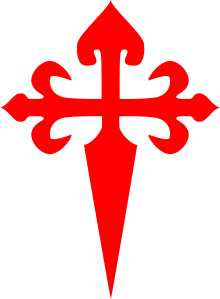Fadrique Alfonso, Lord of Haro
| Don Fadrique Alfonso | |
|---|---|
| Lord of Haro | |
 Cross of the Order of Santiago | |
| Born |
13 January 1334 Seville |
| Died |
29 May 1358 (aged 24) Seville |
| Noble family | House of Enríquez |
| Spouse(s) | Leonor de Angulo |
| Issue | |
| Father | Alfonso XI of Castile |
| Mother | Eleanor of Guzman |
Fadrique Alfonso of Castile, 1st Señor de Haro (1334–1358), 25th Master of the Order of Santiago (1342–1358), was the fifth illegitimate child of Alfonso XI of Castile and Eleanor of Guzman. He was born in Seville.[1]
Biography
Fadrique was a twin to Henry of Trastámara. While his father lived, the children of Eleanor profited from appointments and royal grants. With this backing, in 1342, Fadrique rose to the leading role of Maestre of the militant monastic Order of Santiago.[2] The prior Maestre had been Alonso Meléndez de Guzmán, his maternal uncle.
When Alfonso XI died suddenly in a siege of Gibraltar, attempts were made by his half brother King Pedro I, his mother, and her court favorite, the Duke of Albuquerque to disposess the entire family of Eleanor. This and the subsequent execution of Eleanor in Talavera in 1351, led to rebellion by Eleanor's sons, Henry, future Henry II of Castile, Fadrique, Tello of Castile, and Sancho of Castile, Count of Alburquerque. Each rebelled from their independent corners of the Spanish kingdom. Through a combination of threats and diplomacy, Peter I of Castile was able to elicit fealty and a temporary reconciliation with his half-brothers. But this was not to last. Fadrique was named royal emissary to France, where he went to escort Pedro's bride, Blanche of Bourbon. The subsequent turmoil of this marriage and Pedro's entanglement with his mistress, María de Padilla, was unlikely to have help cement a relationship between Pedro and Fadrique.
In 1354, Fadrique was granted the role as custodian (Adelantado Mayor de la Frontera) of the Portuguese frontier.[3] Here, along with his brother Henry, they again began to plot rebellion, entering in negotiations with Juan Alfonso de Alburquerque, formerly a foe and the favorite of Pedro's court, but now fallen from favor with the king. Henry ultimately also went to seek support from the French monarchy. A second rebellion was launched against Pedro, this time others joined including the city of Toledo, who requested help from Fadrique. He arrived with 700 soldiers.
Again Pedro cajoled with a mixture of forgiveness and with the mediation of Juan Fernández de Henestrosa, uncle of María de Padilla, and for a second time Fadrique was reconciled to Pedro and offered a post with the court. Pedro even invited Fadrique to Seville, with the pretext of seeking his council.
The subsequent events were chronicled most famously by Pero Lopez de Ayala, a contemporary historian, but one who ultimately worked under the victorious Henry II, the full brother of Fadrique. Some later historians found the characterization of Pedro as a cruel murderer as propaganda.
Once in Seville, Fadrique and his knights met with the king. Paying visits to the King's mistress, he apprehended the threatened treachery, and rushed to the stables at the Alcázar of Seville. Soldiers of the king separated Fadrique from his knight companions, and in a courtyard of the Alcazar, he was murdered with a mace hit from behind. Ayala claims the King asked for his lunch to be brought to him there, so that he could dine in front of the moribund Fadrique. Other stories hold that he was captured and ultimately directly executed by the king.[4]
After his murder, his body was interred in the Cathedral of Seville. In 1579, his mortal remains were transferred to the crypt of the royal chapel where they remain to this day.
Descendants
As Maester of the Order of Santiago, Fadrique was putatively required to remain celibate. Through illegitimate marriages he fathered the lineage of the Enríquez family, who became Admirals of Castile and later Dukes of Medina de Rioseco.[2]
By an unknown woman (possibly a Sephardic Jewish woman named Paloma), he had one illegitimate son:
- Alfonso Enríquez de Castilla (b. 1354, d. 1429), 1st Señor de Medina de Río Seco, married to Juana de Mendoza (b. circa 1360, d. January 24, 1431), had issue
By Leonor de Angulo y Córdoba (b. c. 1340), a Castilian noblewoman, he had two illegitimate children:
- Pedro Enríquez de Castilla (b. 1355, d. May 5, 1400), 1st Conde de Trastámara, 2nd Constable of Castile, married in 1385 to Isabel de Castro (b. circa 1360), had issue
- Leonor Enríquez de Castilla (b. circa 1357), married to Diego Gómez Sarmiento, Marshall of Castile (b. circa 1355, d. August 14, 1385), had issue.
His descendant Juana Enriquez (1425 – February 13, 1468), was the second wife of John II of Aragon and the mother of Ferdinand II of Aragon.
Ancestors
| Ancestors of Fadrique Alfonso, Lord of Haro | ||||||||||||||||||||||||||||||||||||||||||||||||||||||||||||||||||||||||||||||||||||||||||||||||||||||||||||||||||||||||||||||||||||||||||||||||||||||||||||||||||||||||||||||||||||||||||||||||||||||||||||||||||||||||||||||||||||||||||||||||||||||||||||||||||||||||||||||||||||||||||||||||||||||||||||||||||||||||||||||||||||||||||||||||||||||||||||||||||||||||||||||||||||||||||||||||||||||||||||||||||||||||||||||||||||||||||||||||||||||||||||||||||||||||||||||||||||||||||||||||||||||||||||||||||||||||||||||||||||||||||||||||||||||||||||||||||||||||||||||||||||||||||||||||||||||||||||||||
|---|---|---|---|---|---|---|---|---|---|---|---|---|---|---|---|---|---|---|---|---|---|---|---|---|---|---|---|---|---|---|---|---|---|---|---|---|---|---|---|---|---|---|---|---|---|---|---|---|---|---|---|---|---|---|---|---|---|---|---|---|---|---|---|---|---|---|---|---|---|---|---|---|---|---|---|---|---|---|---|---|---|---|---|---|---|---|---|---|---|---|---|---|---|---|---|---|---|---|---|---|---|---|---|---|---|---|---|---|---|---|---|---|---|---|---|---|---|---|---|---|---|---|---|---|---|---|---|---|---|---|---|---|---|---|---|---|---|---|---|---|---|---|---|---|---|---|---|---|---|---|---|---|---|---|---|---|---|---|---|---|---|---|---|---|---|---|---|---|---|---|---|---|---|---|---|---|---|---|---|---|---|---|---|---|---|---|---|---|---|---|---|---|---|---|---|---|---|---|---|---|---|---|---|---|---|---|---|---|---|---|---|---|---|---|---|---|---|---|---|---|---|---|---|---|---|---|---|---|---|---|---|---|---|---|---|---|---|---|---|---|---|---|---|---|---|---|---|---|---|---|---|---|---|---|---|---|---|---|---|---|---|---|---|---|---|---|---|---|---|---|---|---|---|---|---|---|---|---|---|---|---|---|---|---|---|---|---|---|---|---|---|---|---|---|---|---|---|---|---|---|---|---|---|---|---|---|---|---|---|---|---|---|---|---|---|---|---|---|---|---|---|---|---|---|---|---|---|---|---|---|---|---|---|---|---|---|---|---|---|---|---|---|---|---|---|---|---|---|---|---|---|---|---|---|---|---|---|---|---|---|---|---|---|---|---|---|---|---|---|---|---|---|---|---|---|---|---|---|---|---|---|---|---|---|---|---|---|---|---|---|---|---|---|---|---|---|---|---|---|---|---|---|---|---|---|---|---|---|---|---|---|---|---|---|---|---|---|---|---|---|---|---|---|---|---|---|---|---|---|---|---|---|---|---|---|---|---|---|---|---|---|---|---|---|---|---|---|---|---|---|---|---|---|---|---|---|---|---|---|---|---|---|---|---|---|---|---|---|---|---|---|---|---|---|---|---|---|---|---|---|---|---|---|---|---|---|---|---|---|---|---|---|---|---|---|---|---|---|---|---|---|---|---|---|---|---|---|---|---|---|---|---|---|---|---|---|---|---|---|---|---|---|---|---|---|---|---|---|---|---|---|---|---|---|---|---|---|---|---|---|---|---|---|---|---|---|---|---|---|---|---|---|---|---|---|---|---|---|---|---|---|---|---|---|---|---|---|---|---|---|---|---|---|---|---|---|---|---|---|---|---|---|---|---|---|---|---|---|---|---|---|---|
| ||||||||||||||||||||||||||||||||||||||||||||||||||||||||||||||||||||||||||||||||||||||||||||||||||||||||||||||||||||||||||||||||||||||||||||||||||||||||||||||||||||||||||||||||||||||||||||||||||||||||||||||||||||||||||||||||||||||||||||||||||||||||||||||||||||||||||||||||||||||||||||||||||||||||||||||||||||||||||||||||||||||||||||||||||||||||||||||||||||||||||||||||||||||||||||||||||||||||||||||||||||||||||||||||||||||||||||||||||||||||||||||||||||||||||||||||||||||||||||||||||||||||||||||||||||||||||||||||||||||||||||||||||||||||||||||||||||||||||||||||||||||||||||||||||||||||||||||||
| Preceded by Alonso Meléndez de Guzmán |
Grand Master of the Order of Santiago 1342–1358 |
Succeeded by Garci Álvarez de Toledo |
References
- ↑ Douglas Richardson; Kimball G. Everingham; David Faris (2004). Plantagenet Ancestry: A Study In Colonial And Medieval Families. Genealogical Publishing. ISBN 0-8063-1750-7.
- 1 2 "Fadrique Alfonso, Master of Santiago", Fernão Lopes's chronicles, University of Georgia
- ↑ Pedro the Cruel of Castile, 1350–1369 By Clara Estow
- ↑ Cronicas de los reyes Castilla: Don Pedro, Volume 1 By Pedro López de Ayala, Eugenio Llaguno y Amirola, Jéronimo Zurita, Page 238